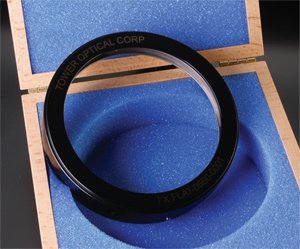
How to Select the Right Waveplate for Laser Polarization
Tuesday, 13 May, 2025
What Are Waveplates in Precision Optics—and Why Coatings Matter
Sunday, 22 June, 2025Introduction
In the realm of precision optics, accuracy is everything. Whether you’re calibrating an interferometer, testing a surface for flatness, or aligning complex optical assemblies, one tool stands out for its indispensable role in ensuring optical perfection: the transmission flat. At Tower Optical, we specialize in crafting high-precision transmission flats to meet the stringent requirements of laboratories, aerospace, defense, and advanced manufacturing environments. But what exactly are transmission flats—and why are they critical in optical testing?
What Is a Transmission Flat?
A transmission flat is a precision-polished, optically flat piece of glass or fused silica used primarily in interferometric testing. It serves as a reference surface for evaluating the flatness, quality, and alignment of another optical surface by comparing the wavefronts of light that reflect or transmit through both surfaces.
Transmission flats typically feature:
Surface flatness down to λ/20 or better (where λ is the wavelength of the light used)
Coatings (such as antireflection or partially reflective coatings) depending on the application
High-quality materials like fused silica or Zerodur® to ensure thermal stability
How Do Transmission Flats Work?
Transmission flats are often used in interferometers, instruments that superimpose light waves to measure surface irregularities. The flat is placed in the optical path of the interferometer, and light passing through it reflects off both the flat and the test surface.
This produces an interference pattern (called fringes), which reveals any deviations from flatness. A perfect surface will produce straight, equally spaced fringes. Deviations in the fringe pattern indicate surface aberrations such as:
Curvature (concave or convex)
Surface roughness
Irregularities from manufacturing or handling
This process is non-contact and highly sensitive—ideal for delicate or coated optical surfaces.
Key Applications of Transmission Flats
1. Interferometric Surface Testing
Transmission flats are a cornerstone of Fizeau interferometers, allowing metrologists to determine the flatness or figure of optical surfaces with nanometer-level precision.
2. Optical Component Calibration
They are used to calibrate other optical components, such as mirrors or lenses, particularly those in high-performance systems like telescopes or laser assemblies.
3. Quality Assurance in Manufacturing
In high-end optics production, manufacturers use transmission flats to verify that surfaces meet stringent quality control metrics, ensuring system performance and reliability.
4. Alignment in Optical Assemblies
During assembly of multi-element systems, transmission flats can help verify proper alignment by confirming the planarity of components or mounts.
Why Material Choice Matters
The substrate material of a transmission flat plays a significant role in its accuracy and long-term stability. Fused silica is often chosen due to its:
Low thermal expansion coefficient
High optical homogeneity
Excellent transmission in UV to IR ranges
These qualities ensure that the flat retains its shape and performance even under varying temperature conditions or over extended periods of use.
Flatness Grades and Standards
Surface flatness is usually specified in fractions of a wavelength (e.g., λ/4, λ/10, λ/20). For example, a λ/20 transmission flat at 632.8 nm (HeNe laser wavelength) indicates that the surface deviation is no more than 31.6 nanometers. Standards are guided by MIL-PRF-13830B and other optical industry specifications.
Coating Options
Depending on the intended use, transmission flats can be supplied with:
Antireflection (AR) coatings for improved transmission
Partially reflective coatings for interferometry
Protective coatings for harsh environments
These coatings can extend durability and enhance measurement fidelity.
Maintenance and Handling
Because of their sensitivity, transmission flats must be:
Kept in a clean, dust-free environment
Handled only with clean gloves or vacuum wands
Stored in padded, vibration-resistant containers
Cleaned with optical-grade solvents using non-abrasive materials
Even small contaminants can introduce measurement errors or damage the surface.
Why Precision Matters
A poorly made or damaged transmission flat can compromise the accuracy of your entire optical test setup. That’s why quality assurance, traceable metrology, and precision polishing are essential. At Tower Optical, every transmission flat is manufactured with meticulous care, using state-of-the-art equipment and decades of expertise.
Final Thoughts
Transmission flats are quiet heroes in the world of precision optics. While they may seem simple in appearance, their ability to serve as a flawless reference makes them foundational in ensuring the highest levels of optical performance. Whether you’re testing optics for a laser system or verifying the flatness of mirrors for space applications, a high-quality transmission flat can make all the difference.
Learn More
To explore Tower Optical’s full line of transmission flats and other high-precision optical components, visit https://www.toweroptical.com or contact our applications team for custom solutions tailored to your needs.
Sources:
Hecht, E. Optics, 5th ed. Addison-Wesley.
Malacara, D. Optical Shop Testing, 3rd ed. Wiley.
National Institute of Standards and Technology (NIST) – Optical Metrology Standards
Tower Optical Co., Inc. internal manufacturing and quality protocols



